Vietnam joined Asean day 28-07
28.07.2021
On July 28, 1995, Viet Nam officially joined ASEAN, marking the regional integration process of Viet Nam as well as the cooperation and connectivity progress of the region.

ASEAN is a top priority in Vietnam’s foreign policy
 For more than a quarter of a century – 26 years of living under the “common roof” of ASEAN, Vietnam has made very important contributions to the Association.
For more than a quarter of a century – 26 years of living under the “common roof” of ASEAN, Vietnam has made very important contributions to the Association.
It can be said that the past 26 years have witnessed strong changes and transformations of both ASEAN and Vietnam. ASEAN has become a successful, dynamic and innovative regional organization with the fifth largest economic potential in the world, attracting the attention and cooperation of the international community.
Meanwhile, Vietnam, from a country with a subsidized and backward economy, has become a middle-income country with a dynamic market economy and is actively integrating deeply into the region and the world. world. From the early steps, Vietnam is now an active, active and responsible member, joining hands with other ASEAN member countries to respond to emerging challenges, as well as contribute to solving the problem. strategic issues related to peace, development and prosperity of ASEAN; thereby, contributing to promoting the position of ASEAN as well as the position of Vietnam in the region and internationally.
The development orientation of ASEAN in the coming time is very consistent with the policy of Vietnam. ASEAN has always been one of the top priorities in Vietnam’s foreign policy. While enjoying the benefits brought by the ASEAN Community, Vietnam will continue to proactively propose initiatives and orientations to join hands in building the Community. A strong and resilient ASEAN Community will be a solid support for Vietnam to overcome the growing difficulties and storms in the coming time.
Also one year ago, Hanoi Telecom was honored to receive the Top 10 typical ASEAN enterprises in the Program “ASEAN Economic Cooperation Conference 2020”, thanks to its efforts in fighting the epidemic and innovating and developing.
On July 31, 2020, the Vietnam Small and Medium Enterprises Research Institute in collaboration with the Singapore International Chamber of Commerce, the Singapore Federation of Manufacturers and other units organized the Program “ASEAN Economic Cooperation Enterprises”. 2020” – Theme “Vietnamese enterprises post-Covid, opportunities & challenges”.

In fact, during the Covid-19 pandemic in 2020, the Vietnamese business community has been promoting the spirit of overcoming difficulties, self-reliance, self-reliance, striving to maintain production and business and jobs for employees. Many initiatives have been implemented to overcome the negative impacts of the epidemic such as applying flexible working hours; cut production costs; review and search for alternative sources of raw materials; actively search for product consumption markets, quickly seize new business opportunities; Applying digital technology in production and business…
For example, Hanoi Telecom has maximized its initiatives to join hands with the government to stamp out the epidemic. Typically, Hanoi Telecom pioneered with the decision to “work from home” in the first days of new infections in both the 1st and 2nd phase of the Covid-19 epidemic. Besides, policies to support charges for customers and charity programs to support hospitals are still regularly implemented by Hanoi Telecom.
Especially in the context of the epidemic, Hanoi Telecom’s telecommunications services have a better chance of growth, especially during the period of social distancing with high-quality internet for studying and working. many policies to remove difficulties such as reducing administrative procedures and costs for businesses; accelerate the implementation progress, improve the transparent business environment.
 Deputy General Director of Hanoi Telecom – Nguyen Hien Phuong – said that this is a good time for Hanoi Telecom to take advantage of innovation in working methods and attract human resources, one of the important factors that help Hanoi Telecom create a big push in the post-Covid-19 epidemic period.
Deputy General Director of Hanoi Telecom – Nguyen Hien Phuong – said that this is a good time for Hanoi Telecom to take advantage of innovation in working methods and attract human resources, one of the important factors that help Hanoi Telecom create a big push in the post-Covid-19 epidemic period.
With many efforts to combat the Covid-19 epidemic in the first half of 2020, at the event, Hanoi Telecom was honored to receive the top 10 ASEAN typical enterprises. Ms. Nguyen Hien Phuong – Deputy General Director was honored as ASEAN’s outstanding talent manager. This is a very meaningful award for Hanoi Telecom at the moment, the award recognizes a part of Hanoi Telecom’s efforts during the past time.
In 2021, Hanoi Telecom continues to make further strides in business and development. We have a big celebration on the 20th anniversary of the company’s establishment. We are honored for the first time to reach the Top 10 Prestigious Information Technology – Telecommunications Companies in 2021.
In order to achieve such great achievements, the Board of Directors has constantly strived and constantly transmitted the fire to generations of employees, and also learned and absorbed the youth and creativity from them. We all together make Hanoi Telecom what it is today.
In these difficult days of the epidemic, and the distance, Hanoi Telecom’s Board of Directors is still constantly thinking about new directions during the pandemic, and always promises to accompany and stand side by side with the capital, together with the whole community. employees, confident that we will stand firm and overcome as many difficulties before.

(Source: Collection of information)
Hanoi Telecom corporation reached Top 10 prestigious Information Technology – Telecommunications Companies in 2021
22.07.2021
On July 20, 2021, Vietnam Report Joint Stock Company (Vietnam Report) officially announced the list of Top 10 Reputable Technology Companies in 2021.
The reputation of the Technology Enterprises is evaluated quantitatively, objectively, scientifically and independently, based on the results of the financial assessment of the business, assessing the reputation of the business in the media by means of Media coding , assessment of stakeholders; and was announced according to 02 lists: Top 10 Information Technology – Telecommunications Companies and Top 10 Technology Companies providing Services, Software solutions & Reputable System Integration in 2021.
List 1: Top 10 prestigious Information Technology – Telecommunications Companies in 2021
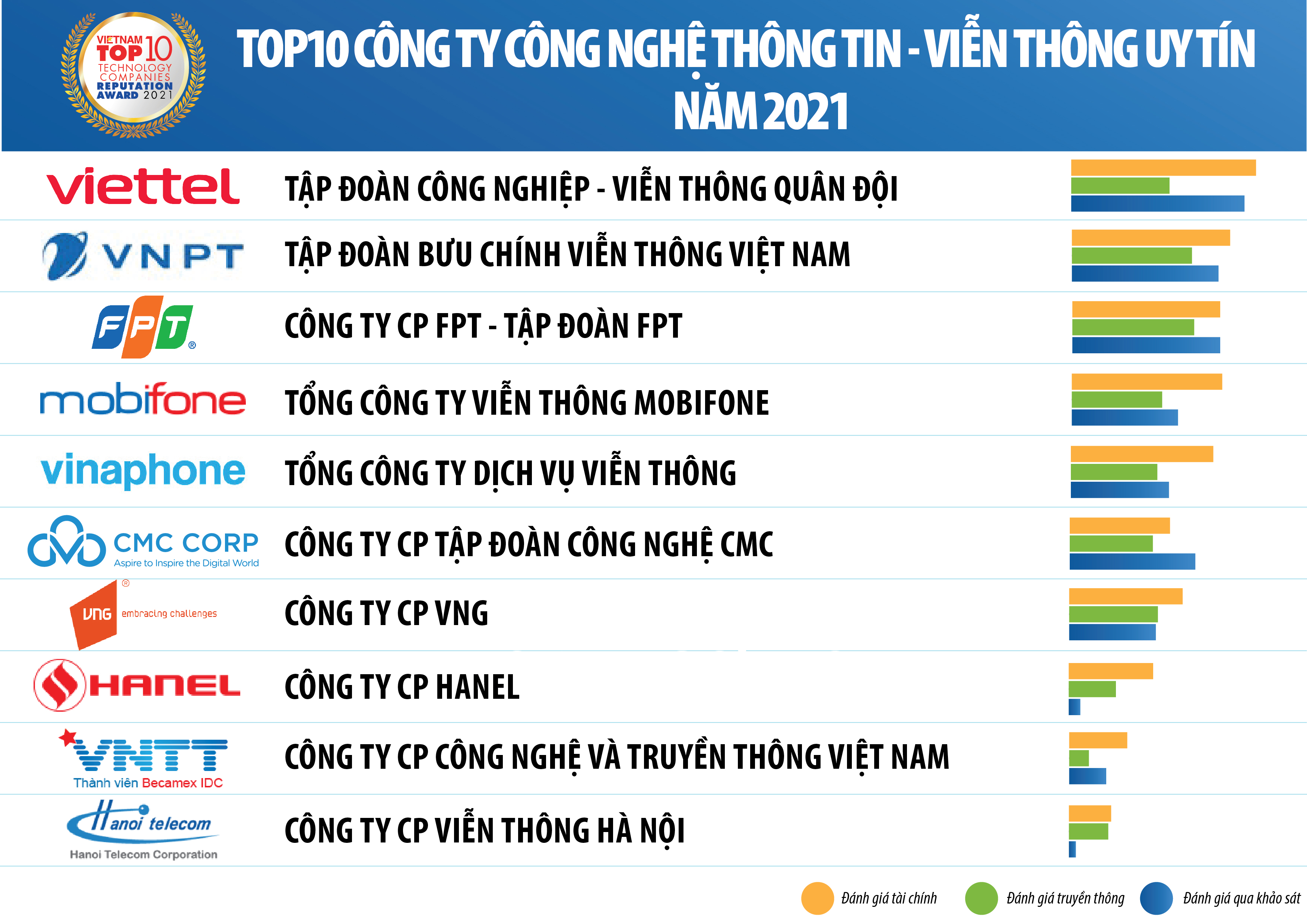
Source: Vietnam Report, Top 10 Reputable Technology Companies in 2021, July 2021
List 2: Top 10 Reputable Service Providers, Software Solutions & System Integration Technology Companies in 2021

Source: Vietnam Report, Top 10 Reputable Technology Companies in 2021, July 2021
For more information about Top 10 Reputable Technology Companies in 2021, please visit website: https://toptenvietnam.vn/
Information Technology – Telecommunications Market: Traditional market saturation and opportunities for new trends
The COVID-19 pandemic in the past 2 years has posed many challenges and difficulties for the whole economy as well as the business community, businesses in general are struggling to find their own way to strengthen and maintain production and business activities. In the context of such market gloom, the Information Technology – Telecommunications (IT-VT) industry emerged as a rare bright spot of the economy.
The world economy recorded a negative growth rate of 4.3% in 2020 (World Bank data) and under the impact of the pandemic, many industries are also in the negative growth trend such as retail (-5.7) %), aviation (-60.9%), while the technology industry has improved significantly in the second half of 2020. According to Gartner, the world IT market is only growing (-3.2). %) in Q4 2020, while Q3 was (-5.4%). Total global IT spending in 2020 is estimated at nearly $3.7 trillion.
In Vietnam, GDP in 2020 grew by 2.91% in the context of the pandemic, in which, the IT industry still maintained its upward momentum although somewhat slowed down compared to the previous period. According to a report of the Ministry of Information and Communications, the total revenue of Vietnam’s ICT industry in 2020 will reach 120 billion USD. According to estimates from Statista, a company specializing in market and consumer data (Germany), Vietnam’s IT service revenue is estimated at 1.12 billion USD, a slight increase compared to 2019 (1.1 billion USD). . In 2021, Statista forecasts that revenue will regain the momentum it was before the pandemic broke out, this year’s forecast number is more than 1.18 billion USD, and continue to increase to 1.43 billion USD in 2025. .
The pandemic has accelerated the need and wave of digital transformation and technology investment in many organizations and businesses across the country. This is both a challenge for businesses in the ICT industry and creates a clear opportunity for the sustainable development of technology companies pioneering in providing solutions, platforms, digital transformation services and products. In particular, the trend of digital transformation may become stronger when customers realize the importance of digitalization after the COVID-19 epidemic such as reducing costs, increasing efficiency, etc.
In 2021, IT enterprises are expected to benefit from the trend of digital transformation in Vietnam and around the world and with the increase of technology investment packages.
In the survey report in March 2021 with Vietnam Report’s Top 500 fastest growing enterprises in Vietnam, it also shows that ICT is in the Top 7 industries assessed with the most potential in the next three years. Information/Telecommunications took the lead with 72.7%. This result reflects the current development trend of enterprises, which is promoting the application of digital transformation in management and operation.
Figure 1: Top 7 potential industries in the next three years
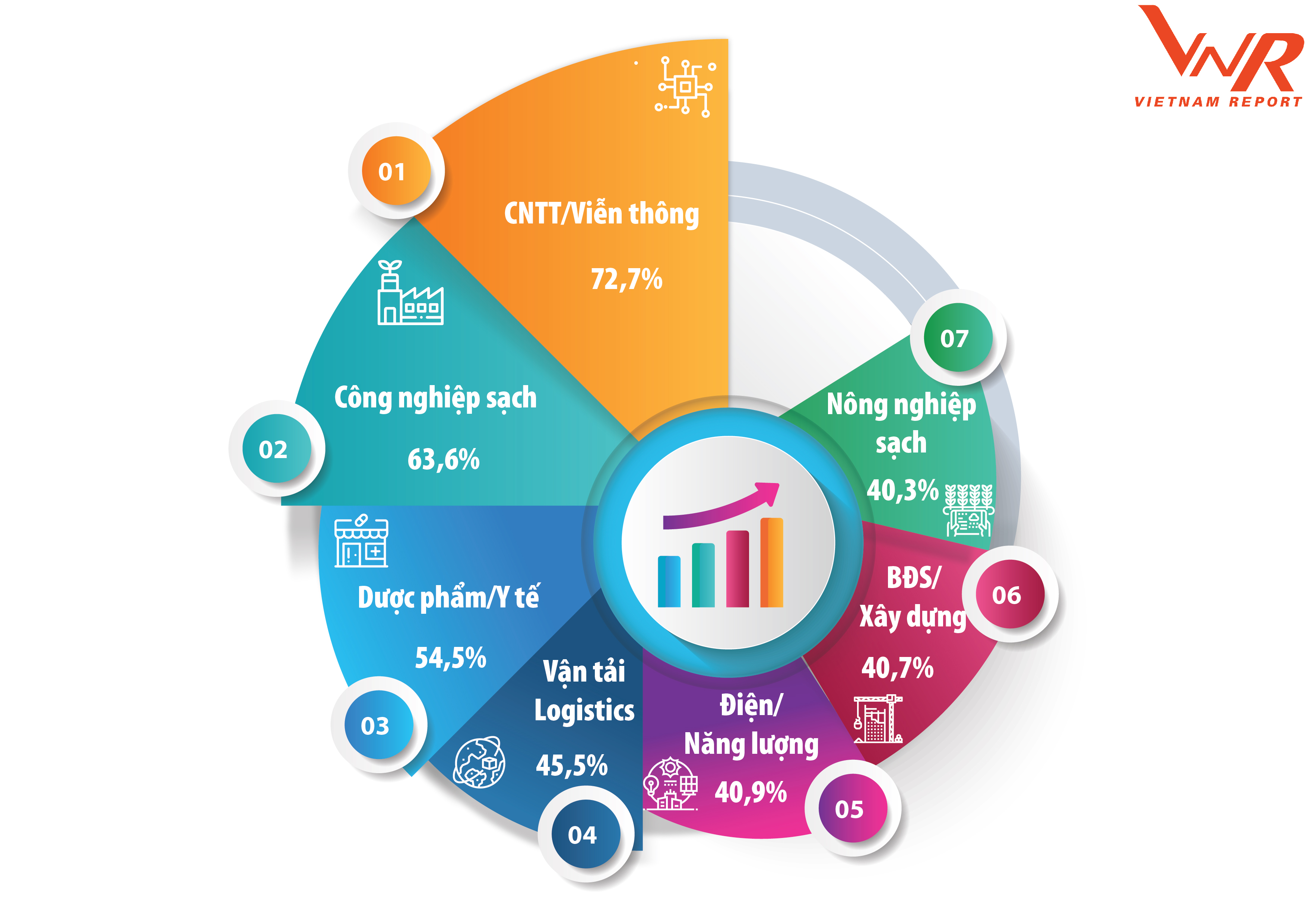
Source: Vietnam Report, FAST500 Enterprise Survey, March 2021
The saturation of traditional services
In the survey and interviews with enterprises and industry experts by Vietnam Report, although Vietnam’s ICT industry has recorded many strides in the modernization and expansion of the system in recent years, however, the Traditional telecommunications services have reached saturation, and it is difficult for them to achieve high growth, especially in the strong development trend of OTT (Over-The-Top application) applications such as Facebook, Zalo, Skype , Viber, etc. will make revenue from traditional telecommunications services decline faster.
According to statistics from the Department of Telecommunication, Ministry of Information and Communications, in 2019 the whole country had about 125.7 million mobile subscribers. With a total population of about 96.2 million people, on average each citizen will own 1.30 mobile subscribers, nearly equal to developed countries such as Korea and Japan. This shows that the market is saturated and it will be difficult to develop new subscribers.
The main trends in the ICT industry in the coming time
It is the saturation of the traditional product and service market that is opening up new opportunities for emerging trends in the market. In the current context, the technology experts interviewed by Vietnam Report all agreed that the online trend is the mainstream and to do that, it is necessary to further develop cloud technology. Cloud), 5G telecommunications infrastructure, Fiber optic cable, Data Center, Mobile Web. In the early stages to save resources, it is possible to build pre-packaged platforms instead of doing it step by step. A combination considered by experts to be extremely important, is a vital resource for businesses to catch up with online trends in the next normal period: Data; Enterprise IP; Personnel.
In particular, the following trends will emerge in the next normal period:
Figure 2: Some key trends of the ICT market in the next normal
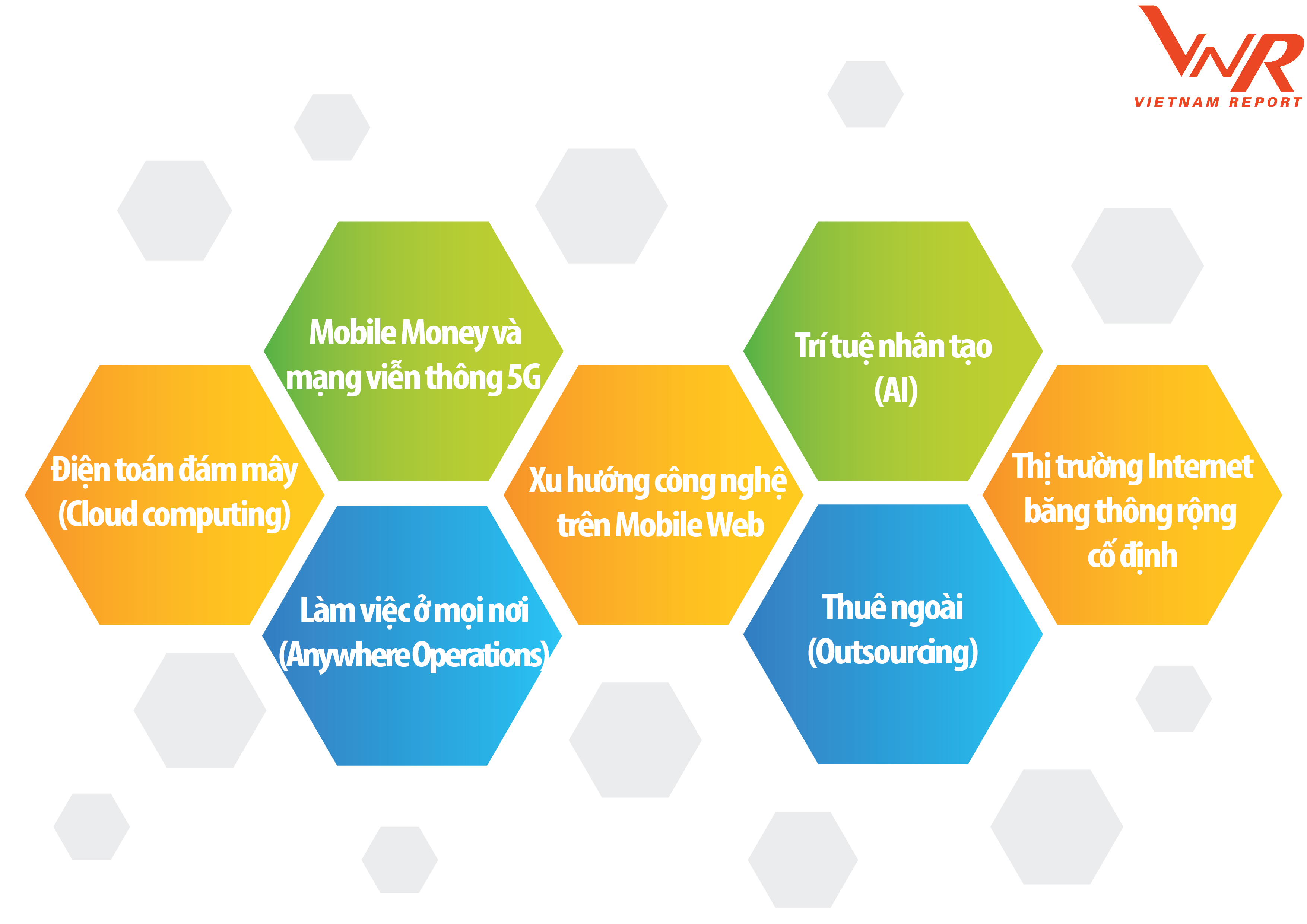
Source: Vietnam Report, Survey of Technology Enterprises in Vietnam, June 2021
Mobile Money and 5G telecommunications network
These are considered two important trends affecting the long-term prospects of ICT enterprises. Mobile Money, if licensed to deploy on a large scale, will be a big hit for users and both small and medium businesses. According to Vietnam Digital Report 2021, as of January 2021, there are 154.4 million mobile connections in Vietnam, this is considered a great opportunity to deploy Mobile Money in the near future. Then all issues related to transfers, purchases and loans, even reviewing credit records, will be significantly shortened when deploying Mobile Money, but comprehensive regulations are required to avoid overlapping roles between banks and organizations providing Mobile Money services in the future.
Meanwhile, the development of 5G network is considered as a new development driving force for ICT. 5G networks are an important factor in promoting fast and efficient digital transformation on a large scale. Vietnam is currently one of the countries that soon deploys 5G and is in the group of 10 countries with the highest level of deployment of new-generation Internet addresses globally.
According to GSMA Intelligence, the number of 5G subscribers in Vietnam is expected to account for about 5% of the total number of mobile subscribers in 2025. On the other hand, the early deployment of 5G services is also likely to help the revenue of operators. Vietnam’s mobile network will increase by about 300 million USD/year from 2025. Currently, Viettel, VNPT and MobiFone are the operators that are testing 5G, expected to officially commercialize the service in 2021.
Artificial Intelligence (AI)
Survey data and interviews with experts of Vietnam Report all show that one of the things that AI does best in the present and in the next few years is to help businesses understand customers and deliver customer experiences. best for customers. Obviously, this is the most optimal way for businesses to lead in growth. With the rapid development of science and technology in the flat world, almost the barriers and gaps in product quality between suppliers are no longer too different, and so the customer experience is the factors that determine the competitiveness and list of loyal customers of a business. AI is the most powerful tool to do this, AI will help businesses know their customers, understand who they are and what they want, and better control service quality. Stories about Facebook and Amazon clearly demonstrate this trend. And this is the right time for Vietnamese businesses to quickly approach AI and race on the road to understanding customers.
Cloud Computing (Cloud Computing)
In the context of an ever-changing and interconnected world, where data needs to be analyzed and processed quickly and accurately, old business standards have become obsolete. The migration and upgrade to cloud computing (Cloud Transformation) is essentially the transformation of outdated systems (old platforms like IBM Lotus Note) into cloud computing (such as Office 365), or replacing existing resources. processing resources from existing data centers, with resources on cloud computing platforms (Amazon Web Services, or Microsoft Azure…), will help businesses reduce operating costs, increase growth potential, and find new sources of capital. Identifying and optimally using opportunities like cloud computing to stay ahead of the competition is a prominent trend in the near future.
Technology trends on Mobile Web
The mobile trend is expected to dominate the technology industry in the next few years, which poses an urgent requirement for e-commerce systems to quickly update the latest technology trends to enhance the experience. experience for users on mobile, especially mobile web. According to Google statistics, 80% of smartphone users have a high probability of closing from companies with mobile apps. This is an opportunity for large e-commerce systems to increase the user experience when ordering or paying online on the mobile web.
Fixed Broadband Internet Market
The market of fixed broadband Internet (optical cable) in Vietnam is making great progress. The number of fixed broadband Internet subscribers has continuously increased sharply in recent years, by the end of November 2020, the total number of subscribers has reached more than 16.5 million. On average, in the period 2016-2020, fixed broadband subscribers grow by 15%/year, mobile broadband subscribers increase by 22%/year. The potential and room for the development of fixed broadband Internet is considered to be still large when the rate of fixed broadband Internet subscribers in Vietnam is currently about 17.2 subscribers/100 people, which is relatively low compared to that of Vietnam. The East Asia – Pacific region has about 23 subscribers per 100 people.
The promulgation of the Government’s “National Digital Transformation Program” with many goals to develop the digital government, digital society, and digital economy, in which digital infrastructure plays an important role in the digital transformation. country and the goal of “universalizing fiber-optic broadband Internet services” to the entire population is a very good premise for developing the broadband Internet market in Vietnam in the coming time, especially in the context of the telephone market. While messaging is continuously declining in both revenue and profit, fixed broadband Internet is expected to become one of the solid fulcrums for the growth momentum of network operators in the future.
Anywhere Operations (Anywhere Operations)
This trend became more apparent during the COVID-19 pandemic. At its core, this operating model enables businesses to access, deliver, and work from anywhere – wherever customers, employers and business partners operate in a physical environment from far. It’s more than simply working from home or interacting with virtual customers – it also delivers a unique value-added experience across 5 core areas: collaboration and productivity, secure remote access, cloud infrastructure, quantifying digital experiences, and automation to remotely support .
Outsourcing (Outsourcing)
Outsourcing has always been a stable source of income for IT businesses, creating stability in human resources as well as helping the company quickly acquire a team of skilled software engineers. Experts interviewed with Vietnam Report all shared the same opinion that in the context of supply in the world’s Outsourcing capitals like India being more or less affected by the pandemic, Outsourcing in the short term is expected to explode .
Digital transformation in technology enterprises: Opportunities, Challenges and Strategic Priorities
Strong businesses will create a solid foundation for a strong and strong country. The strong concept of a business is no longer a large workforce or huge facilities. A strong and highly competitive enterprise in the market is reflected in four factors (1) access to capital, (2) source of raw materials, (3) level of technology application and (4) management level. In which, the level of technology application and management level are closely related to technology and in such a context, digital transformation plays an important role in the technology application strategy in each enterprise. from pioneering technology enterprises to enterprises in different industries.
In a survey conducted by Vietnam Report in June 2021 with technology businesses, the COVID-19 push has accelerated digital transformation in businesses (82.4%), this is also one of the 03 major opportunities to develop Vietnam’s IT industry in the next few years according to enterprises and experts participating in the survey. Digital transformation is transforming the way businesses operate on the basis of information technology systems, so it must come from a business problem. The core of digital transformation is the business system of enterprises, ERP (Enterprise Resource Planning – enterprise resource planning system).
Figure 3: Top 3 opportunities of the IT industry in the coming time
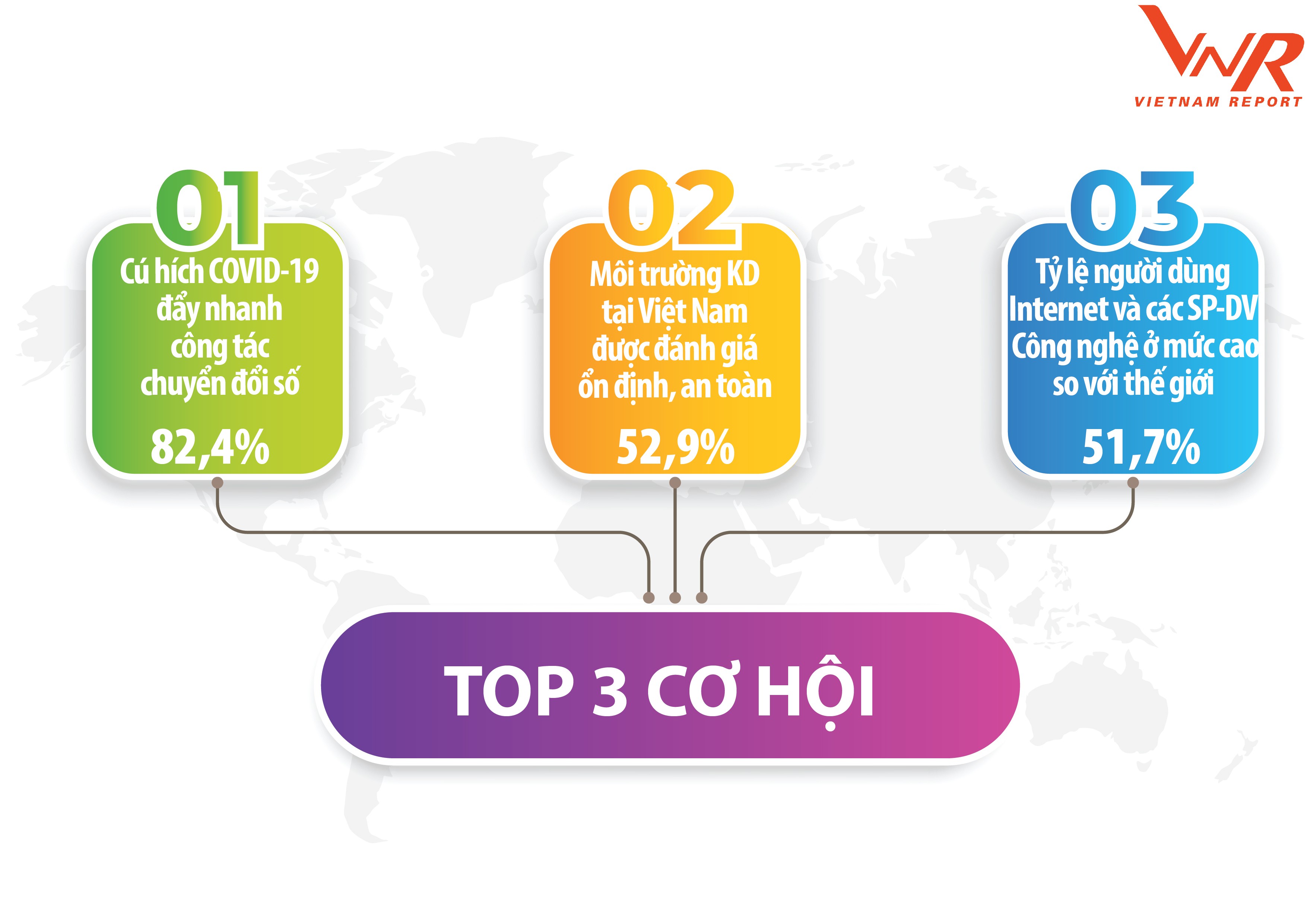
Source: Vietnam Report, Survey of Technology Enterprises in Vietnam, June 2021
According to experts participating in a survey of Vietnam Report, digital transformation for SMEs often uses applications to be in Cloud mode (on cloud). Those businesses themselves don’t build intranets like they used to, and most of them will push it to the cloud. They also do not buy applications that are “tailored” for each business anymore, but directly use quite professional applications and are designed specifically for SMEs. This is a market segment that Vietnamese businesses are doing quite well. However, the number of SMEs is too large, which leads to the story that each business has its own needs. This is a gap and a condition for SMEs in the field of IT and digital transformation to promote their capacity.
In addition to the opportunities that are opening up in the new context, difficulties and challenges are inevitable. According to a survey by Vietnam Report, the top 3 difficulties and challenges that Vietnam’s ICT enterprises are facing in their operations in general and the digital transformation process in particular in the coming time are: Research and development conditions technology product development is still limited (70.6%); Lack of high-quality human resources (64.7%) and Lack of supportive policies, institutions, and legal regulations of the State (58.8%).
Figure 4: Top 3 biggest challenges faced by businesses in the IT industry in digital transformation
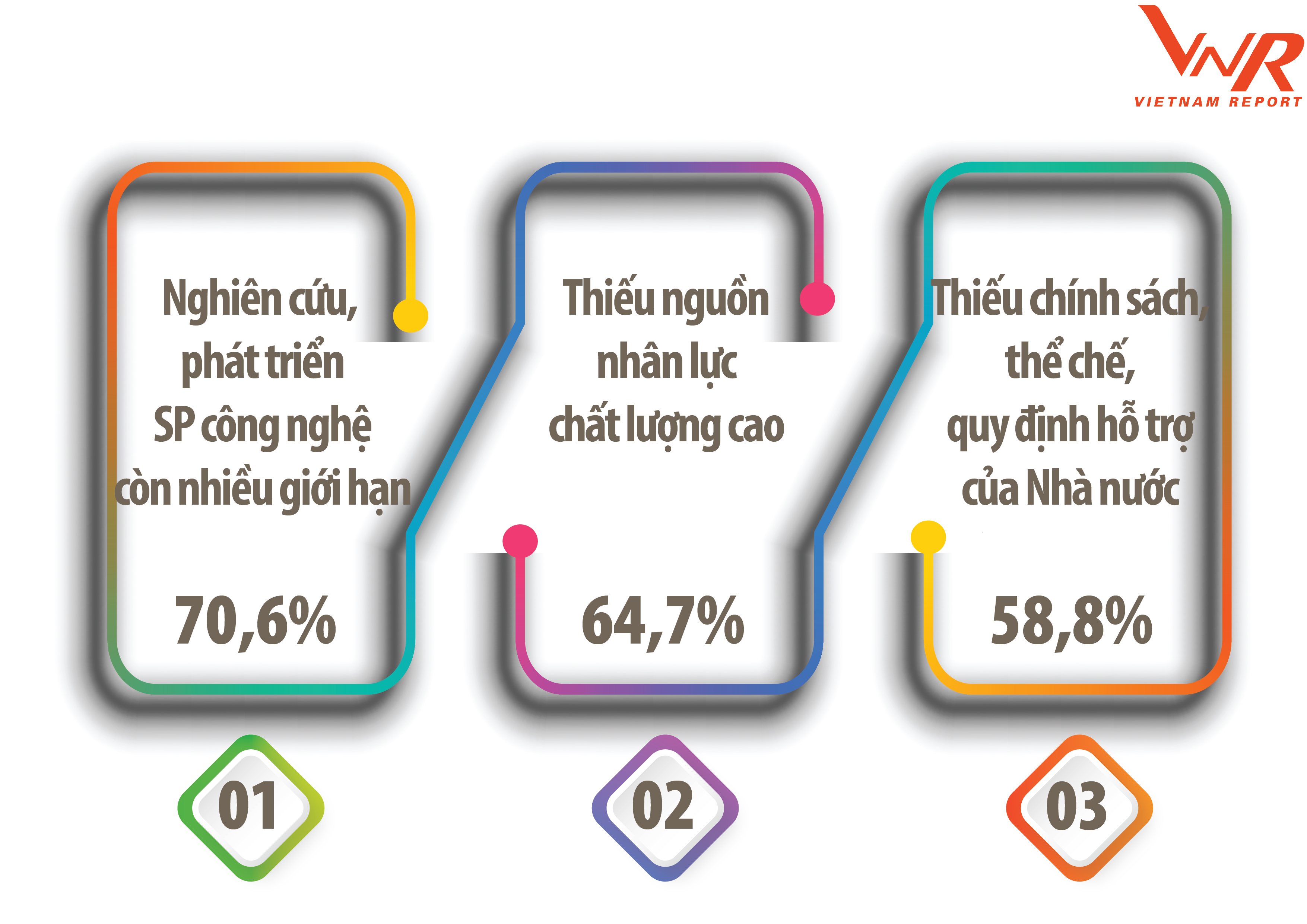
Source: Vietnam Report, Survey of Technology Enterprises in Vietnam, June 2021
Investment in research and development (R&D) continues to be considered a vital task of all ICT enterprises and up to 70.6% of technology enterprises consider this as the biggest barrier to overcome. With the constant change of science and technology, innovation, research and development activities are always the top concern of every technology enterprise. From a macro perspective, R&D activities will create a strong polarization between countries, on the one hand, countries with a good research and science and technology background, and on the other hand, countries that can only science and technology applications. This is still true from a business perspective. In fact, over the years, this activity has always faced certain difficulties and obstacles, in which lack of financial resources is the factor that has the greatest influence on R&D activities at enterprises.
Along with the financial problem, the next difficulty that IT-VT businesses face is the story of human resources according to 64.7% of enterprises. The reality shows that the demand for human resources in the technology field is very large and has always tended to increase sharply over the years. Although Vietnam is in the period of “golden population”, the problem of human resources always brings businesses many difficulties. According to a TopDev report, in 2021 Vietnam needs 450,000 IT human resources. However, the total number of programmers currently in Vietnam (as of Q1/2021) is 430,000, which means 20,000 programmer positions will not be filled in the near future. The cause of this shortage is not due to the lack of training units, but because the training programs at the schools have not been fully updated and focused.
The lack of supportive policies, institutions and legal regulations of the State continues to be the third barrier of ICT enterprises in the coming period, accounting for 58.8%. Before the wave of Industry 4.0, with the openness of Vietnam’s economy today, besides the advantages from the inheritance and application of scientific and technological achievements in the world, ICT enterprises also have to face challenges. with many difficulties and challenges from competition and issues of intellectual property rights. In addition, businesses face obstacles due to the lack of financial institutions and policies related to financial support, access to capital as well as other conditions to use for public investment activities. technology and promote products and services to the world.
Transforming people in the “digital era” – A prerequisite strategy of IT-VT enterprises in the process of digital transformation in the next normal period
Experts interviewed by Vietnam Report shared the same opinion that the causes of failure in the digital transformation process are often the ability and leadership thinking in the digital age has not kept pace. organizations do not fully understand or underestimate the investment required to drive a digital organization. Executives are not investing enough time in digital transformation programs. Staff capacity is not enough to meet. The low digitization infrastructure of enterprises is not yet eligible for rapid transformation .
The survey of Vietnam Report with technology enterprises in June 2021 also shows that the Top 5 priority strategies in digital transformation of technology enterprises are: Strengthening the training of high-quality human resources (76.5). %); Improve the management system, especially the risk management system (64.7%); Strengthening R&D activities (60.2%); Improve competitiveness compared to other technology competitors (58.8%); and Improve the quality of customer care service (56.3%).
Figure 5: Top 5 priority strategies of IT enterprises in digital transformation in the next normal period
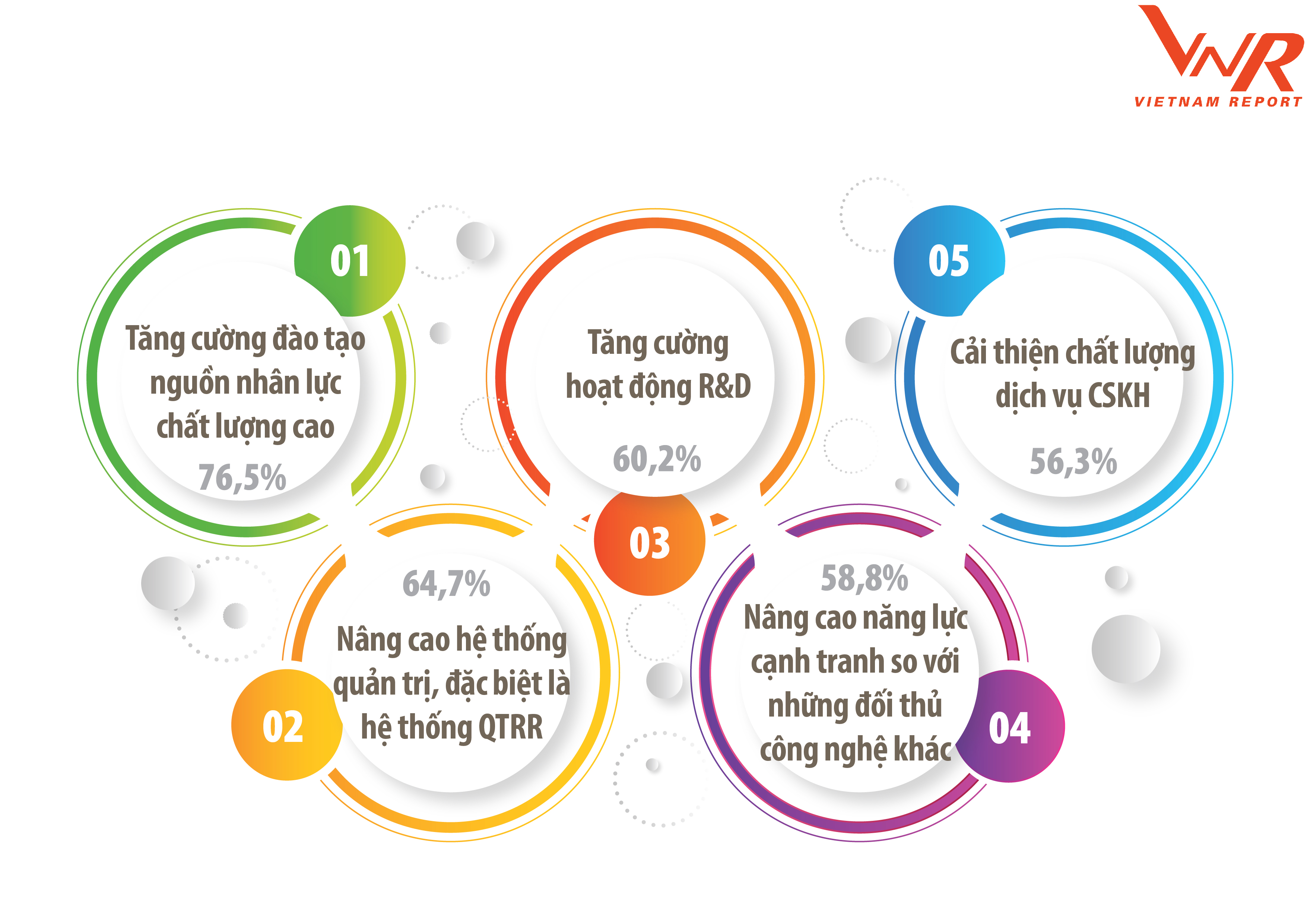
Source: Vietnam Report, Survey of Technology Enterprises in Vietnam, June 2021
As mentioned above, in the face of difficulties from the shortage of high-quality human resources, ICT enterprises in the coming time will focus on promoting the enhancement of human resource training to meet the requirements of the future. increasing demand at work. Specifically, many businesses have used the Fresher training model, which means approaching and inviting potential students to practice at the company since they are still in their 3rd and 4th years for training and Apply knowledge learned in real-world settings. In addition, businesses also create conditions for employees to learn more IT training courses and improve foreign language skills through the purchase of online learning accounts. At the same time, the system will make statistics and rewards to encourage and recognize the progress of each employee in the company.
The next priority strategy of IT enterprises is to improve the management system, especially the risk management system. After many fluctuations in the past time, with the emergence and great impact of the COVID-19 pandemic, this year, many ICT enterprises will continue to improve their management systems, especially especially the risk management system in the Top priority strategy. The next two strategies focused on implementing by ICT enterprises are to strengthen R&D activities and improve competitiveness compared to other technology competitors. These are also two issues that are considered to be big challenges for IT-VT enterprises in the coming time. Thereby, it can be seen that technology enterprises are ready to face the challenge and are determined to overcome it. In addition to management strategies,
Image of IT-VT enterprises in the media
Encrypted communication data of enterprises in the IT-VT industry in the period from June 2020 to May 2021 of Vietnam Report shows that currently, most of the information is still focused on the topic of Customers/ Products accounted for the largest proportion with 20.2%, of which, the number of neutral news accounted for 48.3%, the amount of positive news reached 51.1% and the rest was negative news.
A good sign is that in the past year or so, many businesses have really focused on the image in the media, seriously and methodically investing in building a brand in the hearts of the public, attracting the attention of the public. community attention and concern. As proof, the topic of Image/Public Relations (PR) has risen to the 2nd place in terms of the number of articles, accounting for 15.1%.
Next, the third most mentioned topic group in 24 topic groups is Finance/Business results, accounting for 11.5%. In which, the amount of positive news is 54.7%, negative news is 5.2% and the rest is neutral. From the above results, it can be seen that in the past year, the business results of enterprises in the ICT industry are relatively positive and have great potential for growth.
Figure 6: Top 3 topics with the largest percentage of information in Vietnam’s IT industry
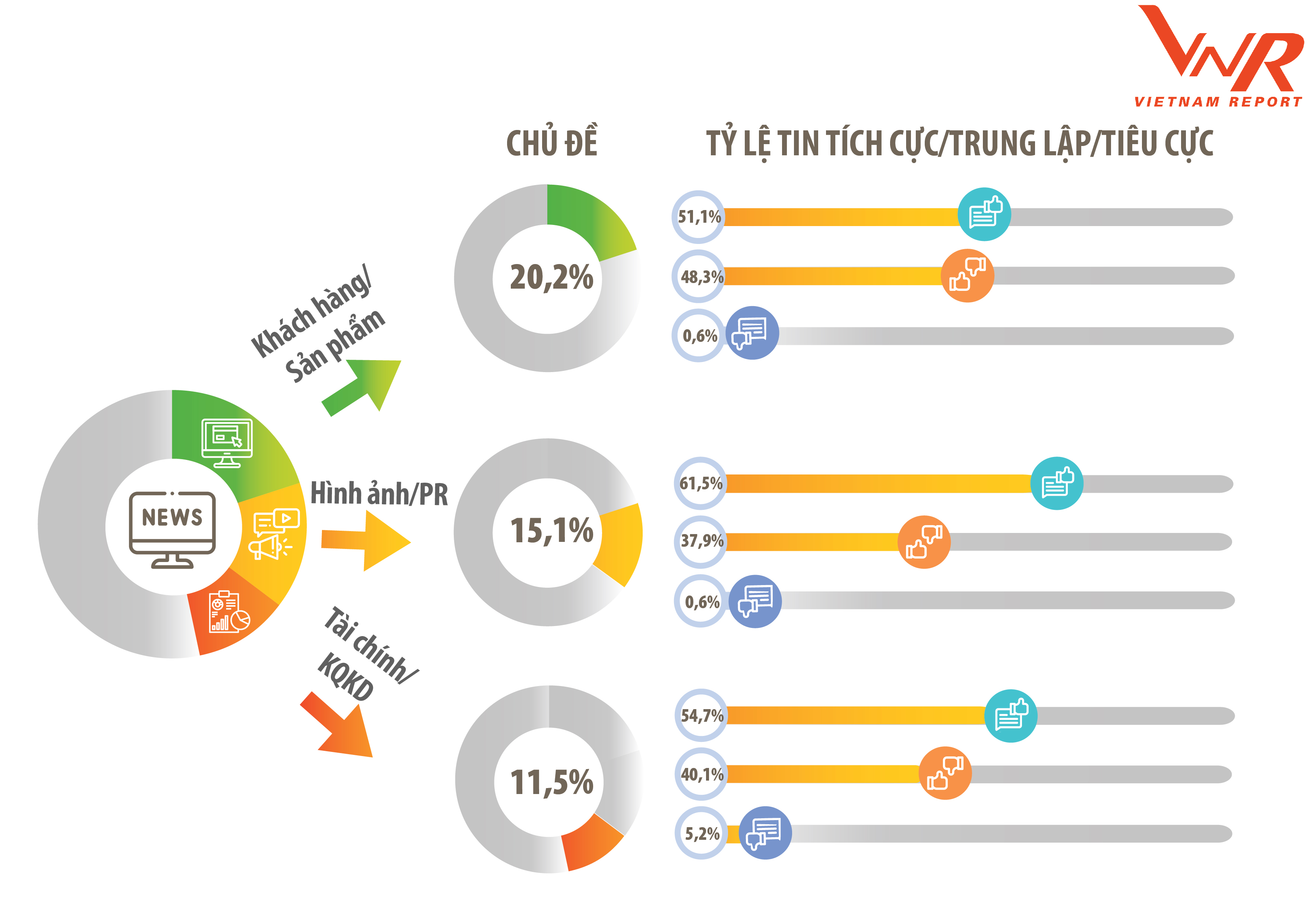
Source: Vietnam Report, Media coding data of IT-VT enterprises in the period from June 2020 to May 2021
In terms of information coverage in the media of technology enterprises, most of them belong to the field of ICT, still with prominent names such as Viettel, VNPT, FPT, MobiFone, Vinaphone, while the frequency of appearance on the communication of enterprises Software solutions and System Integration is very low, only FSOFT enterprises appear the most in this field.
The COVID-19 pandemic has accelerated digital transformation like never before. The pressure from the mandatory application of IT is increasing, so many businesses have seriously embarked on technology investment and identified the core goal in the long-term development orientation as the business strategy. led by technology. Thereby helping businesses optimize resources, deploy and provide services to customers quickly and accurately.
With the outstanding achievements of the ICT industry in recent years, Vietnam has a basis to expect a breakthrough in the future development of this potential field. According to Minister of Information and Communications Nguyen Manh Hung: “National digital transformation, development of digital government, digital economy and digital society to meet the development requirements of the country in the new period”. Faced with that situation, the ICT industry continues to affirm its important role in the development of the country with enormous pervasiveness, contributing to bringing “Make in Vietnam” technology to the world, realizing the aspiration. Vietnam is strong and prosperous.
Certainly, in addition to business goals and affirming their position in the market, each business has the desire to contribute to the country. Especially for enterprises in the ICT industry, this aspiration is even more evident with the advantage of leading and pioneering technology. When the business’s mission is associated with the national mission, the mission of turning Vietnam into a digital country and going global, the path of the business is truly sustainable and long-lasting. With the start of a new cycle, we look forward to a hopeful future with many breakthroughs ahead.
The list of Top 10 reputable companies in the media is an independent and objective research result of Vietnam Report, which has been published annually since 2012, based on the Media Coding method in the media. , combining in-depth research in key industries with high growth potential such as: Banking, Finance, Insurance, Real Estate – Construction, Pharmacy, Food – Beverage, Retail, Tourism, Logistics…
The media analysis research method to assess the reputation of companies is based on the Agenda Setting theory of two professors Maxwell McCombs and Donald L. Shaw about the influence and impact of mass media on the community and implemented and applied by Vietnam Report and its partners since 2012. Accordingly, Vietnam Report has used the Branch Coding method (evaluating the company’s image in the media) to conduct reputation analysis. credit of technology companies in Vietnam.
Vietnam Report conducts coding of articles written about Technology companies published on influential newspapers in Vietnam during the period from June 2020 to May 2021. Articles are analyzed and evaluated at story-level about 24 specific operational aspects of companies from products, business results, markets… to activities and reputation of company leaders. The information selected for coding is based on two basic principles: The company name appears right on the title of the article, or the news about the mentioned company occupies at least 5 lines in the article. , this is called the cognitive threshold – when the information is judged to be of analytical value. The information is evaluated at the following levels: Neutral; Positive; Quite positive; Unclear; Quite negative; Negative.
The statements in the announcement are general and for reference only for businesses and partners; does not represent personal judgment and does not serve the purposes or needs of any particular investor. Therefore, stakeholders should carefully consider the appropriateness of the above information before using it to make investment decisions and take full responsibility for the use of such information.
Website: https://toptenvietnam.vn/
15/07/2021 – World Youth Skills Day in the context of challenging Covid-19
15.07.2021
In 2014, the United Nations General Assembly declared 15 July as World Youth Skills Day. This year, World Youth Skills Day 2021 will again take place in a challenging context due to the ongoing COVID-19 pandemic.
Developing  vocational skills, especially vocational skills for young people, is always the top concern of all countries, the United Nations and other international agencies and organizations. According to United Nations statistics, youth workers (from 15 to 24 years old) account for 16% of the global workforce. The active participation of this labor force helps society to develop in an inclusive, stable and sustainable manner, reducing difficulties and challenges from the impact of climate change, unemployment, poverty, gender inequality, conflict and migration.
vocational skills, especially vocational skills for young people, is always the top concern of all countries, the United Nations and other international agencies and organizations. According to United Nations statistics, youth workers (from 15 to 24 years old) account for 16% of the global workforce. The active participation of this labor force helps society to develop in an inclusive, stable and sustainable manner, reducing difficulties and challenges from the impact of climate change, unemployment, poverty, gender inequality, conflict and migration.

This year, World Youth Skills Day continues to take place in the challenging context, the Covid-19 epidemic continues to linger around the world. Measures to prevent the COVID-19 epidemic have caused many technical and vocational education and training institutions around the world to suspend training activities.
At the present time, Vietnam is also dealing with a large Covid-19 wave from the North to the South. Many localities are still suspending schools, educational and training institutions for such a long time.
With the immediate situation, over the past year, online classes and training have become popular and familiar in schools, training centers, and especially in enterprises from large to small across the country.
Hanoi Telecom also always cherishes and organizes training opportunities for employees from the moment they enter the company, from small classes to long-term courses when given the opportunity, to constantly transmit and update the latest and most advanced knowledge and skills for all employees.
When the Covid-19 epidemic took place, we realized more and more clearly the urgency for staff training and skill improvement, and even more urgent was the formation of a fixed monthly – weekly learning festival for the employees. Then proceed to seminars, sharing experiences and skills in groups.
At this time – in 2021, HANOI TELECOM has successfully created a LEARNING DAY for employees, on the 2nd Friday of every month, to facilitate the organization of training courses on working skills for employees, more methodically and on a larger scale. We call it HTC LEARNING DAY.
On July 9, 2021, the first online course was successfully organized by Hanoi Telecom – HTC learning day in July: “Courses on ENHANCING WORK PRODUCTIVITY ” by Experts – Coach DANG LINH CHI.

The training session attracted nearly 200 employees within 24 hours of launching. This is also an extremely impressive result for the Training Center in general and all students in particular. A very interesting and engaging learning day.
The training center and the students are eagerly looking forward to the upcoming course.
Join our HTC learning day in August. An energetic and valuable class awaits you next month.
Details information about HTC learning day will be continuously updated on Hanoi Telecom’s website and Fanpage.
Website: Hanoi Telecom Corporation – Hanoi Telecom Corporation
Fanpage: https://www.facebook.com/hanoitelecomcorporation
See you all again on the 2nd Friday of August.

 For more than a quarter of a century – 26 years of living under the “common roof” of ASEAN, Vietnam has made very important contributions to the Association.
For more than a quarter of a century – 26 years of living under the “common roof” of ASEAN, Vietnam has made very important contributions to the Association.
 Deputy General Director of Hanoi Telecom – Nguyen Hien Phuong – said that this is a good time for Hanoi Telecom to take advantage of innovation in working methods and attract human resources, one of the important factors that help Hanoi Telecom create a big push in the post-Covid-19 epidemic period.
Deputy General Director of Hanoi Telecom – Nguyen Hien Phuong – said that this is a good time for Hanoi Telecom to take advantage of innovation in working methods and attract human resources, one of the important factors that help Hanoi Telecom create a big push in the post-Covid-19 epidemic period.









 vocational skills, especially vocational skills for young people, is always the top concern of all countries, the United Nations and other international agencies and organizations. According to United Nations statistics, youth workers (from 15 to 24 years old) account for 16% of the global workforce. The active participation of this labor force helps society to develop in an inclusive, stable and sustainable manner, reducing difficulties and challenges from the impact of climate change, unemployment, poverty, gender inequality, conflict and migration.
vocational skills, especially vocational skills for young people, is always the top concern of all countries, the United Nations and other international agencies and organizations. According to United Nations statistics, youth workers (from 15 to 24 years old) account for 16% of the global workforce. The active participation of this labor force helps society to develop in an inclusive, stable and sustainable manner, reducing difficulties and challenges from the impact of climate change, unemployment, poverty, gender inequality, conflict and migration.


